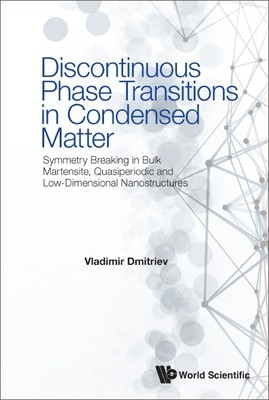
- We will send in 10–14 business days.
- Author: Vladimir Dmitriev
- Publisher: World Scientific Publishing Europe Ltd
- ISBN-10: 1800612915
- ISBN-13: 9781800612914
- Format: 15.2 x 22.9 x 2.5 cm, kieti viršeliai
- Language: English
- SAVE -10% with code: EXTRA
Discontinuous Phase Transitions in Condensed Matter: Symmetry Breaking in Bulk Martensite, Quasiperiodic and Low-Dimensional Nanostructures (e-book) (used book) | bookbook.eu
Reviews
Description
Discontinuous (first-order) phase transitions constitute the most fundamental and widespread type of structural transitions existing in Nature, forming a large majority of the transitions found in elemental crystals, alloys, inorganic compounds, minerals and complex fluids. Nevertheless, only a small part of them, namely, weakly discontinuous transformations, were considered by phenomenological theories, leaving aside the most interesting from a theoretical point of view and the most important for application cases. Discontinuous Phase Transitions in Condensed Matter introduces a density-wave approach to phase transitions which results in a unified, symmetry-based, model-free theory of the weak crystallization of molecular mixtures to liquid-crystalline mesophases, strongly discontinuous crystallization from molten metals and alloys to conventional, fully segregated crystals, to aperiodic, quasi-crystalline structures. Assembly of aperiodic closed virus capsids with non-crystallographic symmetry also falls into the domain of applicability of the density-wave approach.The book also considers the applicability domains of the symmetry-based approach in physics of low-dimensional systems. It includes comparisons of stability of different surface superstructures and metal monoatomic coverage structures on the surface of single-crystalline substrates. The example of the twisted graphene bilayer demonstrates how parametrization in the spirit of an advanced phenomenological approach can establish symmetry-controlled, and therefore model-free, links between geometrical parameters of the twisted bilayer structure and reconstruction of its Brillouin zone and energy bands.
EXTRA 10 % discount with code: EXTRA
The promotion ends in 22d.06:44:22
The discount code is valid when purchasing from 10 €. Discounts do not stack.
- Author: Vladimir Dmitriev
- Publisher: World Scientific Publishing Europe Ltd
- ISBN-10: 1800612915
- ISBN-13: 9781800612914
- Format: 15.2 x 22.9 x 2.5 cm, kieti viršeliai
- Language: English English
Discontinuous (first-order) phase transitions constitute the most fundamental and widespread type of structural transitions existing in Nature, forming a large majority of the transitions found in elemental crystals, alloys, inorganic compounds, minerals and complex fluids. Nevertheless, only a small part of them, namely, weakly discontinuous transformations, were considered by phenomenological theories, leaving aside the most interesting from a theoretical point of view and the most important for application cases. Discontinuous Phase Transitions in Condensed Matter introduces a density-wave approach to phase transitions which results in a unified, symmetry-based, model-free theory of the weak crystallization of molecular mixtures to liquid-crystalline mesophases, strongly discontinuous crystallization from molten metals and alloys to conventional, fully segregated crystals, to aperiodic, quasi-crystalline structures. Assembly of aperiodic closed virus capsids with non-crystallographic symmetry also falls into the domain of applicability of the density-wave approach.The book also considers the applicability domains of the symmetry-based approach in physics of low-dimensional systems. It includes comparisons of stability of different surface superstructures and metal monoatomic coverage structures on the surface of single-crystalline substrates. The example of the twisted graphene bilayer demonstrates how parametrization in the spirit of an advanced phenomenological approach can establish symmetry-controlled, and therefore model-free, links between geometrical parameters of the twisted bilayer structure and reconstruction of its Brillouin zone and energy bands.


Reviews